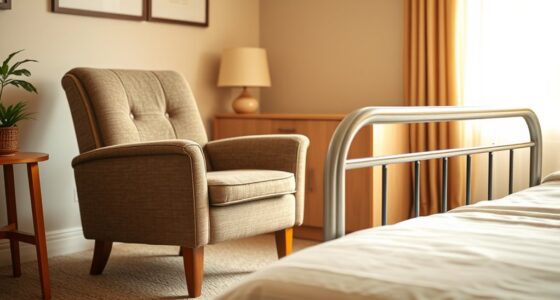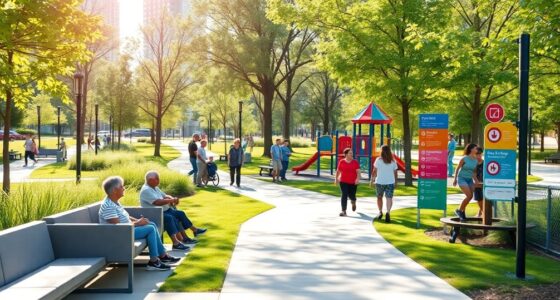Universal design makes your home more accessible, safe, and adaptable for everyone, regardless of age or ability. It focuses on creating spaces that promote independence and comfort through features like wider doorways, non-slip floors, and ergonomic controls. Assistive technologies and smart solutions enhance functionality and ease of use. By incorporating these principles early, your home becomes more flexible and inviting for all. Keep exploring to learn how to incorporate these simple, effective strategies into your space.
Key Takeaways
- Incorporate wide doorways and accessible pathways to ensure easy navigation for all mobility levels.
- Use ergonomic fixtures like lever handles and adjustable countertops to enhance comfort and independence.
- Install assistive technologies such as voice-activated controls and smart lighting for seamless home management.
- Prioritize safety features like non-slip flooring and good lighting to reduce fall risks and promote confidence.
- Design with flexibility in mind to accommodate evolving needs, ensuring longevity and adaptability of the home.

Have you ever wondered how environments can serve everyone equally? When you design a home with universal principles in mind, you create spaces that accommodate people of all ages and abilities. This approach isn’t just about making things accessible; it’s about fostering independence, safety, and comfort for everyone, regardless of mobility or health. One key aspect of achieving this is integrating assistive technology and ergonomic features into your home layout. Assistive technology includes tools and devices that help individuals perform daily tasks more easily, such as voice-activated lighting, smart doorbells, or adjustable countertops. These innovations can substantially enhance your home’s functionality, making it easier for anyone to navigate and use spaces without unnecessary hassle.
Designing homes with universal principles fosters safety, independence, and comfort for all ages and abilities.
Ergonomic features are equally crucial. They focus on designing furniture, fixtures, and spatial arrangements that reduce strain and increase comfort. Think about installing lever-style door handles instead of knobs, which are easier to operate for people with limited grip strength. Countertops that are adjustable or at accessible heights ensure that everyone, regardless of height or mobility level, can prepare meals comfortably. Lighting that can be dimmed or controlled via voice commands helps those with visual impairments or sensitivity issues maintain safe movement throughout the house. These ergonomic considerations aren’t just about convenience—they’re about preventing injuries and promoting confidence in daily routines. Additionally, incorporating smart home technology can further customize and optimize your living environment to meet evolving needs. Moreover, advances in AI integration are making it easier to control multiple home devices seamlessly, increasing safety and comfort. Furthermore, understanding health benefits of accessible design can motivate homeowners to adopt these features for long-term wellness.
Incorporating assistive technology and ergonomic features begins with understanding your specific needs and anticipating future challenges. For instance, if you or someone in your household has limited mobility, you might prioritize wide doorways to accommodate wheelchairs or walkers. Installing non-slip flooring reduces fall risks, while lever handles simplify door operation. Smart home devices can be programmed to respond to voice commands, decreasing the need for physical effort. By thoughtfully combining these elements, you’re creating a space that adapts as needs change, ensuring convenience and safety for years to come. Additionally, universal design principles can guide you in creating a harmonious balance between style and functionality, making your home welcoming for all.
Designing with universal principles doesn’t mean sacrificing style; it’s about blending form and function seamlessly. Modern assistive technology often features sleek, unobtrusive designs, and ergonomic features can complement your aesthetic preferences. When you invest in these features early, you build a home that’s inherently flexible, reducing costly modifications later. Ultimately, prioritizing assistive technology and ergonomic features in your home design makes your living space more inclusive, empowering everyone to live independently and comfortably. It’s about creating an environment that welcomes change, promotes safety, and guarantees that everyone feels at home, no matter their age or ability.
Frequently Asked Questions
How Does Universal Design Impact Property Values?
When considering how universal design impacts property values, you’ll find it enhances market appeal and resale value. Homes with accessible features attract a broader range of buyers, including those seeking age-friendly options, making them more desirable. By incorporating universal design, you’re likely to see a quicker sale and higher offers, as your property stands out in the market and appeals to a diverse group of potential buyers, boosting its overall value.
Are Universal Design Features Suitable for Small Homes?
Small spaces can still showcase smart, stylish, space-saving solutions that support compact accessibility. You’ll find that universal design features are suited for tiny homes, transforming tight quarters into welcoming, functional spaces. By integrating adaptable layouts, you make your home more accessible and appealing without sacrificing style. So, yes—universal design works wonderfully in small homes, turning limited space into a liberating, livable, and lovely environment for everyone.
What Are the Initial Costs of Implementing Universal Design?
When considering the initial costs of implementing universal design, you should conduct a thorough cost analysis and account for your budget considerations. While some features like wider doorways or lever handles may have modest upfront costs, others, such as bathroom modifications or ramps, can be more expensive. Planning ahead helps you allocate resources effectively, ensuring that the investment improves your home’s accessibility without exceeding your financial limits.
Can Universal Design Be Retrofitted Into Existing Homes?
Yes, you can retrofit universal design into your existing home through home remodeling projects. It offers design flexibility, allowing you to adapt your space for better accessibility without a complete overhaul. You might install grab bars, widen doorways, or add step-free entrances. These modifications enhance safety and comfort, making your home more age-friendly and accessible for everyone, regardless of mobility or age.
How Do Universal Design Principles Enhance Safety Beyond Aging?
Universal design principles enhance safety beyond aging by incorporating safety enhancements like slip-resistant flooring and improved lighting, reducing hazards for everyone. You’ll also enjoy environmental benefits, such as energy-efficient fixtures and sustainable materials, which create healthier living spaces. These features not only protect occupants but also promote eco-friendly living, making your home safer and more sustainable for all users, regardless of age or ability.
Conclusion
By embracing universal design, you’re building a house that welcomes everyone like a warm, open arms. It’s not just about adding features; it’s about creating a space where independence and comfort grow together, no matter your age or ability. Think of your home as a garden—when you plant the right seeds now, it blooms beautifully for everyone today and years to come. Make your home a sanctuary that adapts and thrives for all who enter.









